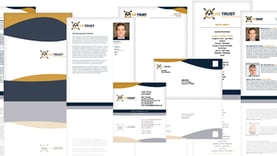“I had another agent refer a client to me and suggested I look at a term conversion strategy for her. But I don’t know when you’d use a strategy like that…” The comment was made during a conversation we recently had with one of our contracted agents. So, in this post, we're going to tackle the topic -- who's a good prospect and what's possible with a convertible term policy...

But first, let’s talk about why someone would purchase a term life insurance policy in the first place. If you sell insurance, there’s a good chance you already know what I’m about to say but bear with me while I set the stage for the rest of our discussion.
Why buy term insurance?
A term policy provides coverage over a specified time period. If the insured passes away during that 10, 20, 30-year term (or longer), whatever it happens to be, the death benefit proceeds would be paid to the beneficiary. At approximately $25 - $35/month (this would vary depending on underwriting factors including age, health, coverage amount and term length), a term policy is typically the least expensive life insurance option. That’s why it’s often purchased as income replacement by younger people who want to protect their family during the insured’s working years -- when they likely have a mortgage and dependent children that would need to be taken care of should the insured pass away and no longer be able to provide for them.
Once the specified time period of the coverage or “term” is up, the policy expires (or auto-renews at often higher premium amount), if no other action is taken.
But here’s what you might not be aware of…
Some term policies allow the policyholder to convert to permanent life insurance. Generally, conversion privileges are part of the policy, however in some instances the policyholder can only convert for a period of time, for example within the first 10 years of a 20-year policy. In those instances, the conversion period can often be extended with an additional rider fee. However it's accomplished-- a convertible term policy is where the possibilities lie that we'll discuss next.
Why convert a term policy to a permanent life insurance policy?
There are 7 major reasons someone who has a term life insurance policy might want to consider doing a conversion to a permanent life insurance policy. If you sell permanent life insurance (whole life, universal life, indexed universal life), you’ll want to pay close attention to what makes a good permanent life insurance prospect in this particular situation.
Who knows, it might even open up potential prospecting opportunities:
1. Insured has a need for a continued death benefit.
This is the number one reason you’d present this option to a client. Because the number one reason for ANY type of life insurance is the need for a death benefit.
Oftentimes when the policy term is up, the coverage ends unless the client wants to start a new term at a higher premium amount. But here's the thing: the insured’s obligations may not be going away. There are plenty of people even in their 40s, 50s, 60s, or even older for example, who still have children (this could possibly be a child with special needs) to care for and/or a mortgage that hasn’t been paid off or college costs they’re planning to pay for. Therefore, if they were to pass away, replacing their income would still be a major concern for the family.
2. The policyholder can afford to cover increased premium costs.
With permanent life insurance comes higher costs because the policy covers the insured’s entire lifetime, provides a guaranteed death benefit, and may offer other features and benefits as well. As a result, the premium amount could be as much as 10- 15X that of a term policy (Quotacy). However, they may be making much more than they did when they bought the term policy, which now makes a permanent life insurance policy feasible.
3. They would like to build up cash value and access it.
A term policy is what’s considered “pure life insurance,” meaning its sole purpose is to pay out a death benefit to the beneficiaries if the insured dies within the term. In contrast, permanent life insurance not only has a guaranteed death benefit, it also has a cash value component to it.
The cash value in a whole life or indexed universal life policy, for example, grows income tax free and that amount can be accessed through withdrawals or loans. So, not only would the policyholder have the income tax-free death benefit to pass on to their beneficiaries, but they’d also have an option to use it as supplemental retirement savings or to pay for college costs, or anything else they might need. And generally, they would not have to pay taxes on it when they took the distribution.
Keep in mind that if they do access the cash value and do not pay it back, the amount would be subtracted from the death benefit when it’s paid out.
4. The insured may have long-term care needs down the road.
Many of today’s permanent life insurance products are hybrid linked-benefit products that make payments to the policyholder to cover costs associated with long-term care. Products that are a combination of life and long-term care are also sometimes referred to as “asset-based” long-term care. Still other carriers of these products provide similar benefits with a “living benefit rider” or “accelerated death benefit rider” on the life insurance product.
Unlike term insurance, permanent life insurance products like this offer the ability to use the life insurance policy while the insured is still living. If they qualify, payments are made to the policyholder to help offset or cover the costs associated with long-term care needs.
With the rising costs of long-term care, permanent life insurance with living benefits like this can be a more cost-effective way for your clients to get the care they need.
5. The insured has estate planning needs.
Policyholders may have purchased a term policy when that was all they could afford, but if their income has since increased or they’ve acquired property, not only can they possibly now afford to pay for permanent life insurance – they may have a greater reason to do so.
Depending on the size of the person’s estate, they may be concerned with the estate taxes their beneficiaries would be responsible for upon their death. A permanent life insurance policy with income tax-free death benefit provides a solution to help their heirs shoulder that estate tax burden.
6. The insured’s health has deteriorated.
One of the major benefits of converting a term policy to a permanent is that the insured would not have to go back through underwriting and would automatically qualify for the same rate class as they did on the term policy. This is called a conversion privilege. If they purchased a policy when they were 20 years old, and are now 50 for example, their health could have significantly changed for the worse. Fortunately, they would not have to undergo additional medical exams to qualify for the permanent policy they may now need.
7. They want to leave a legacy.
At the time a young couple is purchasing term insurance, leaving a legacy may not be on their mind. They are simply buying insurance in the off chance they die prematurely. Just like you buy car insurance in the off chance you have a car accident or homeowner’s insurance for the off chance of a fire. But if those things don’t happen, you’ve paid all the premiums anyway and in many cases, don’t get them back (unless you have a return of premium term insurance policy).
As a policyholder matures and grows their career and their children get older, they may realize they want something to show for the premiums they paid. They want to leave something of value to their heirs. And that’s where a permanent policy with a guaranteed income tax free death benefit sounds appealing. If a term policyholder outlives their insurance, which according to a Penn State University study, 99% of all term policies never pay out a claim (Entrepreneur.com), they won’t have anything to pass along to their children --
unless they have a permanent life insurance policy.
So, let’s say you have a prospect who is an ideal candidate for a term conversion into a whole life or indexed universal life policy. There are few things to be aware of:
-
Term policy renewal or expiration date.
You don’t want the policy to expire before doing the conversion as that will cause the insured to have to go back through underwriting and they may not pass and would be denied coverage. Not good. OR the term policy auto-renews and the annual renewable term rates increase every year – making conversion to a permanent policy cheaper in the long-term. (Although we do work with a carrier where the rates don't change but instead it turns into a decreasing term.) -
Potential policy lapse.
If you’re currently working with term life insurance policyholders who you think might be a candidate to convert down the road, make sure they continue to make their payments until they have the option to convert. If the policy lapses, conversion is not an option. -
Not all insurance carriers allow term conversions.
Make sure the term insurance carrier allows for conversions into another one of their life insurance products. Generally, a policyholder cannot do a term conversion to a permanent policy with another carrier, so this is extremely important to know.
If you’re working with someone who is considering a term policy right now but sees the possibility of a need to convert down the road when they can afford it, it’s even more important to choose a carrier for the term policy that will allow that conversion.
Also keep in mind there may be restrictions on the conversion—in terms of when, at what age, or into which products the conversion can be done. Not all term policies will automatically allow a conversion, however, they may have a term conversion rider that can be purchased. -
Partial conversions may be a more affordable option.
If your prospect or client cannot afford to do a full conversion of their term policy or they don’t need a permanent policy for the entire coverage amount, they may be able to do a partial conversion. This would allow them to maintain their desired death benefit, but also manage premium costs more effectively. But keep in mind, in this scenario, they would be paying premium on the term policy as well as the permanent policy.
With each conversion, they are slowly building up cash value in the permanent policy rather than waiting until sometime in the future when they could afford to do all at once – which would limit the growth they could achieve in terms of cash value to access for supplemental retirement or other needs.
Now that you’ve read this, let’s talk.
Could this “term to perm conversion” strategy be the right fit for your clients? Could you be having conversations with term policyholders about the possibilities of permanent insurance? Do your prospects understand the value of having a convertible term policy?
And what about you as their financial professional -- Do you know which products would be ideal for this strategy?
Schedule a call and let’s talk more about the potential here. We’ve been honing our expertise in this space for years.
Just click the button below and find a time that works for you.






